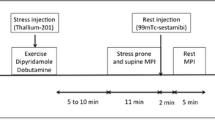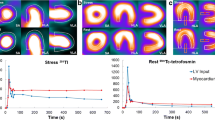Abstract
Background
Detection of reversible ischemia and regional viability by inference from the presence of preserved resting myocardial thickening on dynamic electrocardiographic-gated tomographic (GSPECT) images obtained after stress injection could potentially obviate the need for a separate resting injection. This would decrease the cost, effort, duration, and radiation exposure of diagnostic myocardial perfusion imaging. The aim of this study was to determine whether functional images derived from GSPECT stress myocardial perfusion images, which represent indices of regional wall thickening, could predict the pattern of reversibility of perfusion defects in myocardial segments with severe perfusion defects on stress 99mTc-labeled sestamibi (99mTc-sestamibi) images.
Methods and Results
Reversible ischemia in myocardial segments with severe hypoperfusion (≤50% of normal activity) on stress 99mTc-sestamibi images was assessed with GSPECT indexes of myocardial thickening, as reflected by an increase in regional count density during systole. GSPECT bullseye plots were generated for each of eight frames acquired after stress 99mTc-sestamibi injection in 44 patients with coronary artery disease and at least one severe perfusion defect on summed (ungated) SPECT images. With first harmonic Fourier amplitude (AMP) and AMP/perfusion ratio (APR) images, regional myocardial systolic thickening was assessed according to a nine-segment model as absent, markedly reduced, mildly reduced, or normal thickening. These data were compared on a regional basis with defect reversibility determined with resting sestamibi images. Of 124 severe stress defects, 32 showed absent, 53 minimal, 35 partial, and four complete reversibility on resting images. AMP and APR scores had 75% and 82% agreement on the presence or absence of reversibility on resting images, respectively (both p≤0.00005), and both had significant agreement (p=0.0072 and p≤0.00005, respectively) with resting reversibility grades by kappa analysis. AMP correctly identified 83% of the defects that were reversible on resting images, whereas the APR identified 96% (p=0.0014 for sensitivity of APR vs AMP). On analysis of the triad of segment scores, the AMP slightly underestimated the degree of resting reversibility (p=0.0002), whereas APR images indicated more reversibility than did resting images (p≤0.00005). AMP and APR indicated a greater degree of reversibility than did resting images in at least one myocardial segment in 13 (30%) and 27 (61%) of the 44 patients, respectively.
Conclusions
The presence and degree of reversible ischemia in severe stress sestamibi perfusion defects seen on resting images can be detected reliably by the pattern of regional myocardial thickening demonstrated by Fourier analysis of GSPECT polar maps. When indexed for degree of perfusion, the APR images predict a greater degree of reversibility than do resting images.
Similar content being viewed by others
References
Dilsizian V, Perrone-Filardi P, Arrighi JA, et al. Concordance and discordance between stress-redistribution-reinjection and rest-redistribution thallium imaging for assessing viable myocardium: comparison with metabolic activity by positron emmission tomography. Circulation 1993;88:941–52.
Smart SC. The clinical utility of echocardiography in the assessment of myocardial viability. J Nucl Med 1994;35 (suppl): 49S-58S.
Chua T, Kiat H, Germano G, et al. Gated technetium-99m sestamibi for simultaneous assessment of stress myocardial perfusion, postexercise regional ventricular function and myocardial viability: correlation with echocardiography and rest thallium-201 scintigraphy. J Am Coll Cardiol 1994;23:1107–14.
Johnston DL, Gupta VK, Wendt RE, Mahmarian JJ, Verani MS. Detection of viable myocardium in segments with fixed defects on thallium-201 scintigraphy: usefulness of magnetic resonance imaging early after acute myocardial infarction. Magn Reson Imaging 1993;11:949–56.
Tsukahara R. Myocardial viability in old myocardial infarction as evaluated by T1-201 SPECT and two-dimensional echocardiography. J Cardiol 1991;21:817–25.
Perrone-Filardi P, Bacharach SL, Dilsizian V, Maurea S, Frank JA, Bonow RO. Regional left ventricular wall thickening: relation to regional uptake of 18fluorodeoxyglucose and 201TI in patients with chronic coronary artery disease and left ventricular dysfunction. Circulation 1992;86:1125–37.
DePuey EG, Nichols K, Dobrinsky C. Left ventricular ejection fraction assessed from gated technetium-99m-sestamibi SPECT. J Nucl Med 1993;34:1871–6.
Mochizuki T, Murase K, Fujiwara Y, Tanada S, Hamamoto K, Tauxe WN. Assessment of systolic thickening with thallium-201 ECG-gated single-photon emission computed tomography: a parameter for local left ventricular function. J Nucl Med 1991; 32:1496–500.
Takeda T, Toyama H, Ishikawa N, et al. Quantitative phase analysis of myocardial wall thickening by technetium-99m 2-methoxy-isobutyl-isonitrile SPECT. Ann Nucl Med 1992;6:69–78.
Berman DS, Kiat HS, Van-Train KF, Germano G, Maddahi J, Friedman JD. Myocardial perfusion imaging with technetium-99m-sestamibi: comparative analysis of available imaging protocols. J Nucl Med 1994;35:681–8.
Cooke CD, Garcia EV, Cullom SJ, Faber TL, Pettigrew RI. Determining the accuracy of calculating systolic wall thickening using a fast Fourier transform approximation: a simulation study based on canine and patient data. J Nucl Med 1994;35:1185–92.
Force T, Bloomfield P, O’Boyle JE, et al. Quantitative two-dimensional echocardiographic analysis of motion and thickening of the interventricular septum after cardiac surgery. Circulation 1983;68:1013–20.
Schneider RM, Weintraub WS, Klein LW, Seelaus PA, Agarwal JB, Helfant RH. Rate of left ventricular functional recovery by radionuclide angiography after exercise in coronary artery disease. Am J Cardiol 1986;57:927–32.
Presti CF, Armstrong WF, Feigenbaum H. Comparison of echocardiography at peak exercise and after bicycle exercise in evaluation of patients with known or suspected coronary artery disease. J Am Soc Echocardiogr 1988;1:119–26.
Kloner RA, Allen J, Cox TA, Zheng Y, Ruiz CE. Stunned left ventricular myocardium after treadmill testing in coronary artery disease. Am J Cardiol 1991;68:329–34.
Marzullo P, Parodi O, Sambuce G, et al. Does the myocardium become “stunned” after episodes of angina at rest, angina on effort, and coronary angioplasty? Am J Cardiol 1993;71:1045–51.
Rahimtoola SH. The hibernating myocardium (editorial). Am Heart J 1989;117:211–21.
Braunwald E, Rutherford JD. Reversible ischemic left ventricular dysfunction: evidence for the “hibernating myocardium” (editorial). J Am Coll Cardiol 1986;8:1467–70.
Cuocolo A, Pace L, Ricciardelli B, Chiariello M, Trimarco B, Salvatore M. Identification of viable myocardium in patients with chronic coronary artery disease: comparison of thallium-201 scintigraphy with reinjection and technetium-99m-methoxyisobutyl isonitrile. J Nucl Med 1992;33:505–11.
Dilsizian V, Arrighi JA, Diodati JG, et al. Myocardial viability in patients with chronic coronary artery disease: comparison of 99m-Tc-Sestamibi with thallium reinjection and [18F]fluorodeoxyglucose. Circulation 1994;89:578–87.
Author information
Authors and Affiliations
Rights and permissions
About this article
Cite this article
Williams, K.A., Taillon, L.A. Reversible ischemia in severe stress technetium 99m-labeled sestamibi perfusion defects assessed from gated single-photon emission computed tomographic polar map fourier analysis. J Nucl Cardiol 2, 199–206 (1995). https://doi.org/10.1016/S1071-3581(05)80056-X
Received:
Accepted:
Issue Date:
DOI: https://doi.org/10.1016/S1071-3581(05)80056-X




